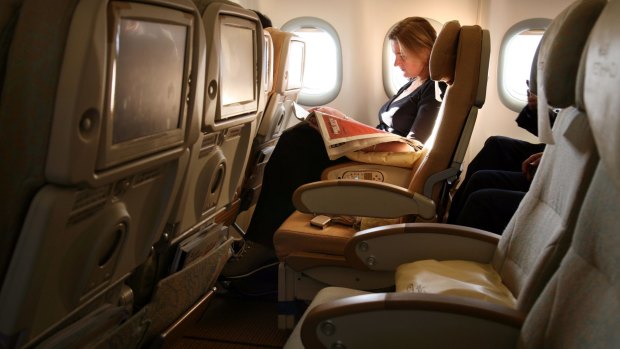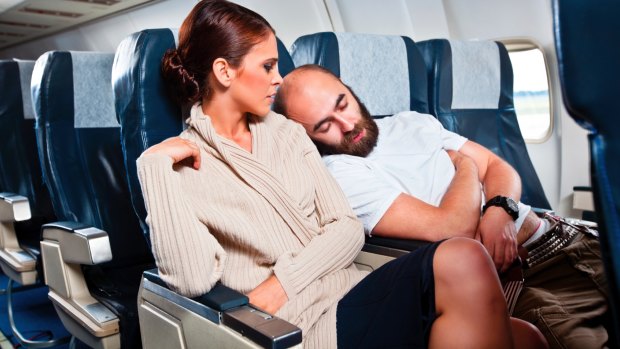This was published 7 years ago
The best time to fly to get an empty seat next to you on a plane
By Michael Gebicki
What determines the timing of your next overseas holiday?
Chances are it's a basket of factors. Maybe the school holidays, the date of a special celebration, the weather and what's on at your destination or the various commitments of friends and family, but there's also a chance that airline seat availability and the price you'll pay for your air ticket might feed into the equation.
The number of passengers travelling on aircraft in any particular month is a fair indication of what your seat is going to cost. Travel in a less busy month and there is also a greater chance of seat availability for travellers looking to pay with airline loyalty points.

Get an empty seat next to you if you fly at the right time.Credit: Alamy
An emptier aircraft also ramps up the comfort factor, increasing the possibility of an empty seat alongside. If the travel gods smile, you might even get a whole row all to yourself (or almost a whole plane - see the link below).
See also: Qantas A380 superjumbo to LAX flies almost empty
On the other hand, if you fly during a busy time, you risk being on an overbooked flight. And given what has happened on the now-infamous United Airlines Flight 3411 this week, that's something you want to avoid.

This is the situation you are trying to avoid.Credit: iStock
So how do you maximise your chances of getting on board a flight with no one sitting next to you, allowing you to spread out?
Comparison site finder.com.au has recently come up with data to show that passenger loadings on aircraft departing Australia are at their lowest in October, at 72 per cent, highest in December at 88 per cent.
According to a finder.com spokesperson, this data was compiled from an analysis of more than 500,000 outgoing flights between 2011-2016, carrying a total of almost 100 million passengers.
Drilling down further into the data, those figures vary depending on your destination. If it's Europe, June and December are the peak months for travel with average loadings for all airlines of 90 and 89 per cent respectively, with April just one percentage point behind.
Come October however and flight loadings drop by more than 20 per cent from September. October is still a great month to visit southern Europe, with generally benign weather, smaller crowds and often cheaper accommodation.
If you're heading for North America, once again June and December are the highs, still with a significant although smaller drop in October.
For both Europe and North America, May sees fewer passengers flying than during the following northern hemisphere summer months.
Adding another level of detail to the data, finder.com has crunched the numbers and come up with a seat utilisation figure, showing loadings for individual airlines on average across the survey period. In first place is All Nippon Airways with 91 per cent of seats full, particularly impressive since the airline only recommenced its Australia-Japan services less than two years ago.
In second and third place, passenger loadings for American Airlines and Delta suggest both are doing a great job of packing their planes, with United further down the ladder at 81 per cent of seats full.
Qantas scores 79.9 per cent, ahead of Emirates but trailing Cathay Pacific, Etihad and Singapore Airlines.
At the bottom of the ladder, Air Niugini has been flying out of Australian ports with just 54 per cent of its seats full over the five years of the survey period. Next up from the bottom are two Philippines-based carriers, the national airline and low cost carrier Cebu Pacific, and just how long this LCC will stay in the Australian market with passenger loads of under 60 per cent is anyone's guess.
As well as aircraft loadings, another factor that could influence your timing is ticket price, and flight search engine momondo.com has a cutting edge tool to help you decide when to book to score a great deal.
At the momondo.com website, key in your origin, destination and prospective dates, hit "Search" then click "Flight Insight" in the upper right corner. Your screen lights up with a handsome graphic that tells you which week in the year is the cheapest for flights, how many days in advance to book to get the cheapest deal, which airport at your destination city costs least to fly into, the cheapest day of the week for your departure and even whether a morning, noon, afternoon or evening flight costs less.
Source for the data is fares on your route from momondo.com's database. In the case of a fare from Sydney to Casablanca, that database consists of 726,853 fares. If it's Melbourne to Paris, the database has close to 11 million fares.
While there are plenty of travel websites that will tell you, for example, that 39 days in advance is the ideal time to book your airfare, and Wednesday is the cheapest day to fly, that doesn't apply to every destination.
Before momondo's Flight Insight, no other website has offered such precise and detailed information tailored specifically to each unique combination of origin and destination.
An aircraft with fewer occupied seats, and a lower cost ticket? Worth thinking about for your next overseas adventure.
See also: Like rock stars - three women get an entire plane to themselves
See also: The real reason planes fly empty
Sign up for the Traveller newsletter
The latest travel news, tips and inspiration delivered to your inbox. Sign up now.